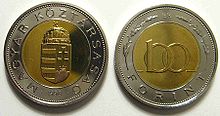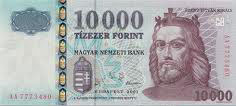|


The forint (sign: Ft; code: HUF) is the currency of Hungary. It is divided into 100 fillér, although fillér coins are no longer in circulation. The introduction of the forint on 1 August 1946 was a crucial step of the post-WWII stabilization of the Hungarian economy, and the currency remained relatively stable until the 1980s. Transition to market economy in the early 1990s deteriorated the value of the forint, inflation peaked at 35% in 1991. Since 2001, inflation is single digit and the forint was declared fully convertible. The forint is the only currency once used by a socialist European state that is still in circulation. As a member of the European Union, the long term aim of the Hungarian government is to replace the forint with the euro.
History
The forint's name comes from the city of Florence, where golden coins were minted from 1252 called fiorino d'oro. In Hungary, florentinus (later forint), also a gold-based currency, was used from 1325 under Charles Robert and several other countries followed its example.
Between 1868 and 1892, the forint was the name used in Hungarian for the currency of the Austro-Hungarian Empire, known in German as the Austro-Hungarian gulden or Austrian florin. It was subdivided into 100 krajczár (krajcár in modern Hungarian).
The forint was reintroduced on 1 August 1946, after the 1945-1946 hyperinflation of the pengő. The process was managed by the Hungarian Communist Party, which held the relevant ministry seats, and the forint's success was exploited for political gains, contributing to the 1948-49 communist take-over of state powers. The forint replaced the pengő at the rate of 1 forint = 4×1029 pengő. In fact, this was an imaginary exchange rate, since the whole amount of pengő in circulation had a value of less than one forint at this rate[citation needed]. Of more significance was the exchange rate to the adópengő of 1 forint = 200 million adópengő.
Historically the forint was subdivided into 100 fillér, although fillér have been rendered useless by inflation and have not been in circulation since 1996. The Hungarian abbreviation for forint is Ft, which is written after the number with a space between. The name fillér, the subdivision of all Hungarian currencies since 1925, comes from the German word Heller. The abbreviation for the fillér is f, written also after the number with a space in between.
After its 1946 introduction, the forint remained stable for several years, but started to lose its purchasing power as the state-socialist economic system lost its competitiveness during the 1970s and 1980s. After the democratic change of 1989-90, the forint saw yearly inflation figures of app. 35% for three years, but significant market economy reforms helped stabilize it. Since year 2000 the relatively high value of forint (especially compared to the falling US dollar and to some extent to the euro) handicaps the strongly export-oriented Hungarian industry against foreign competitors with lower valued currencies.
As part of Hungary's integration into the European Union and its euro currency, the forint may disappear between 2012 and 2014, depending on the economic situation. As of autumn 2005[when?], there is a strong disagreement between the Hungarian National Bank and the government whether EU-mandated low inflation figures and reduced foreign debt aims can be fulfilled by 2010. The situation threatens to make Hungary the last to adopt the euro currency of the ten countries that joined the EU in 2004. The forint was pegged to the euro until 26 February 2008.
Coins
In 1946, coins were introduced in denominations of 2, 10, 20 fillérs and 1, 2, 5 forints. The silver 5 forint was reissued only in the next year, later it was withdrawn from circulation. 5 and 50 fillérs coins were issued in 1948. In 1967, a 5 forint coin was reintroduced, followed by a 10 forint in 1971 and 20 forint in 1982.
In 1992, a new series of coins was introduced in denominations of 1, 2, 5, 10, 20, 50, 100 and (a somewhat different, 500‰ silver) 200 forint. Production of the 2 and 5 fillér coins ceased in 1992, with all fillér coins withdrawn from circulation by 1999. From 1996, a bicolor 100 forint coin was minted to replace the 1992 version, since the latter was considered too big and ugly, and could be easily mistaken for the 20 forint coin.
Silver 200 forint coins were withdrawn in 1998 (due to their nominal value getting too low compared to their precious metal content), the 1 and 2 forint coins remained in circulation until 29 February 2008. The sum of total purchases are rounded to the nearest 5 forint (to 0 or to 5) when paid with cash. A new 200 forint coin made of base metal alloy was introduced in place of the 200 forint bank note on 15 June 2009.
Banknotes
In 1946, 10 and 100 forint notes were introduced by the Magyar Nemzeti Bank (Hungarian National Bank). A new series of higher quality banknotes (10, 20 and 100 forint) were introduced in 1947-48. 50 forint notes were added in 1953, 500 forint notes were introduced in 1970, followed by 1000 forint in 1983, 5000 forint in 1991.
A completely redesigned new series of 200, 500, 1000, 2000, 5000, 10 000 and 20 000 forint was introduced gradually between 1997 and 2001. Each banknote depicts a famous Hungarian leader or politician on the obverse and a place or event related to him on the reverse. All of the banknotes are watermarked, contain an embedded vertical security strip and suitable for the visually impaired people. The 1000 forint and higher denominations are protected by an interwoven holographic security strip. The notes share the common size of 154 × 70 mm. The banknotes are printed by the Hungarian Banknote Printing Corp. in Budapest on the paper manufactured by the Diósgyőr Papermill in Miskolc.
Commemorative banknotes were also issued recently: 1000 and 2000 forint notes to commemorate the millennium (in 2000) and 500 forint note to commemorate the 50th anniversary of the 1956 revolution (in 2006).
Forgery of forint banknotes is not significant. However, forged 20 000 forint notes printed on the paper of 2000 forint notes after dissolving the original ink might come up and are not easy to recognize. Another denomination preferred by counterfeiters was the 1000 forint note until improved security features were added in 2006. For foreign visitors to Hungary, the main danger lies in exchanging their forint to international currencies. Fake dollars and euro banknotes are commonly disseminated by illegal street money exchangers. For their safety, tourists are advised not to attempt to exchange currency with touts. Legal currency exchange is only available in licensed booths (which are abundant), which always operate under the consortium of some commercial bank and always provide a receipt of the transaction. Clients may be requested to produce a valid photographic ID when exchanging currency. Foreign coins are seldom exchanged, and exchange is normally done at a rate lower than the spot rate. An alternative to currency exchange is to use internationally known and accepted credit cards for payments in Hungary.
The text on this page has been made available under the Creative Commons Attribution-ShareAlike License and Creative Commons Licenses
| 